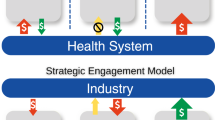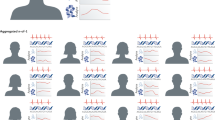Abstract
Information from genomic, proteomic and metabolomic measurements has already benefited target discovery and validation, assessment of efficacy and toxicity of compounds, identification of disease subgroups and the prediction of responses of individual patients. Greater benefits can be expected from the application of these technologies on a significantly larger scale; by simultaneously collecting diverse measurements from the same subjects or cell cultures; by exploiting the steadily improving quantitative accuracy of the technologies; and by interpreting the emerging data in the context of underlying biological models of increasing sophistication. The benefits of applying molecular profiling to drug discovery and development will include much lower failure rates at all stages of the drug development pipeline, faster progression from discovery through to clinical trials and more successful therapies for patient subgroups. Upheavals in existing organizational structures in the current 'conveyor belt' models of drug discovery might be required to take full advantage of these methods.
This is a preview of subscription content, access via your institution
Access options
Subscribe to this journal
Receive 12 print issues and online access
$209.00 per year
only $17.42 per issue
Buy this article
- Purchase on Springer Link
- Instant access to full article PDF
Prices may be subject to local taxes which are calculated during checkout



Similar content being viewed by others
References
Stoughton, R. Applications of DNA microarrays in biology. Annu. Rev. Biochem. 13 Jan 2005 (10.1146/annurev.biochem.74.082803.133212).
de Hoog, C. L. & Mann, M. Proteomics. Annu. Rev. Genomics Hum. Genet. 5, 267–293 (2004).
Lindon, J. C., Holmes, E., Bollard, M. E., Stanley, E. G. & Nicholson, J. K. Metabonomics technologies and their applications in physiological monitoring, drug safety assessment and disease diagnosis. Biomarkers 9, 1–31 (2004).
Nicholson, J. K. & Wilson, I. D. Opinion: understanding 'global' systems biology: metabonomics and the continuum of metabolism. Nature Rev. Drug Discov. 2, 668–676 (2003).
Lindsay, M. A. Target discovery. Nature Rev. Drug Discov. 2, 831–838 (2003).
Weinshilboum, R. & Wang, L. Pharmacogenomics: bench to bedside. Nature Rev. Drug Discov. 3, 739–748 (2004).
Roth, A., Gill, R. & Certa, U. Temporal and spatial gene expression patterns after experimental stroke in a rat model and characterization of PC4, a potential regulator of transcription. Mol. Cell. Neurosci. 22, 353–364 (2003).
Chuaqui, R. F. et al. Post-analysis follow-up and validation of microarray experiments. Nature Genet. 32 (Suppl.), 509–514 (2002).
Lock, C. et al. Gene-microarray analysis of multiple sclerosis lesions yields new targets validated in autoimmune encephalomyelitis. Nature Med. 8, 500–508 (2002).
Clare, A. & King, R. D. How well do we understand the clusters found in microarray data? In Silico Biol 2, 511–522 (2002).
Hughes, T. R. et al. Functional discovery via a compendium of expression profiles. Cell 102, 109–126 (2000).
Hardwick, J. et al. Identification of biomarkers for tumor endothelial cell proliferation through gene expression profiling. Mol. Canc. Ther. (in the press).
Waring, J. F. et al. Clustering of hepatotoxins based on mechanism of toxicity using gene expression profiles. Toxicol. Appl. Pharmacol. 175, 28–42 (2001).
Waring, J. F. et al. Identifying toxic mechanisms using DNA microarrays: evidence that an experimental inhibitor of cell adhesion molecule expression signals through the aryl hydrocarbon nuclear receptor. Toxicology 181–182, 537–550 (2002).
Zielinski, N. et al. Expression profiling using DNA microarray reveals a functional antagonism of the peroxisome proliferator activated receptor alpha by the protease inhibitor, Ritonavir. Conf. Antimicrobial Agents Chemother. Chicago, Illinois (2001).
Engelberg, A. Iconix Pharmaceuticals, Inc. - removing barriers to efficient drug discovery through chemogenomics. Pharmacogenomics 5, 741–744 (2004).
Waring, J. F. et al. Development of a DNA microarray for toxicology based on hepatotoxin-regulated sequences. EHP Toxicogenomics 111, 53–60 (2003).
Steiner, G. et al. Discriminating different classes of toxicants by transcript profiling. Environ. Health Perspect. 112, 1236–1248 (2004).
Gunther, E. C., Stone, D. J., Gerwien, R. W., Bento, P. & Heyes, M. P. Prediction of clinical drug efficacy by classification of drug-induced genomic expression profiles in vitro. Proc. Natl Acad. Sci. USA 100, 9608–9613 (2003).
Marton, M. J. et al. Drug target validation and identification of secondary drug target effects using DNA microarrays. Nature Med. 4, 1293–1301 (1998).
Roberts, C. J. et al. Signaling and circuitry of multiple MAPK pathways revealed by a matrix of global gene expression profiles. Science 287, 873–880 (2000).
van 't Veer, L. J. et al. Gene expression profiling predicts clinical outcome of breast cancer. Nature 415, 530–536 (2002).
van 't Veer, L. J. et al. Expression profiling predicts outcome in breast cancer. Breast Cancer Res. 5, 57–58 (2003).
Petricoin, E. F. et al. Use of proteomic patterns in serum to identify ovarian cancer. Lancet 359, 572–577 (2002).
Mariadason, J. M. et al. Gene expression profiling-based prediction of response of colon carcinoma cells to 5-fluorouracil and camptothecin. Cancer Res. 63, 8791–8812 (2003).
Ochi, K. et al. Prediction of response to neoadjuvant chemotherapy for osteosarcoma by gene-expression profiles. Int. J. Oncol. 24, 647–655 (2004).
Alizadeh, A. A. et al. Distinct types of diffuse large B-cell lymphoma identified by gene expression profiling. Nature 403, 503–511 (2000).
Berns, K. et al. A large-scale RNAi screen in human cells identifies new components of the p53 pathway. Nature 428, 431–437 (2004).
Hartwell, L. H., Szankasi, P., Roberts, C. J., Murray, A. W. & Friend, S. H. Integrating genetic approaches into the discovery of anticancer drugs. Science 278, 1064–1068 (1997).
Houshmand, P. & Zlotnik, A. Targeting tumor cells. Curr. Opin. Cell Biol. 15, 640–644 (2003).
Christopher, R. et al. Data-driven computer simulation of human cancer cell. Ann. NY Acad. Sci. 1020, 132–153 (2004).
Schadt, E. E. et al. Genetics of gene expression surveyed in maize, mouse and man. Nature 422, 297–302 (2003).
Schadt, E. E., Monks, S. A. & Friend, S. H. A new paradigm for drug discovery: integrating clinical, genetic, genomic and molecular phenotype data to identify drug targets. Biochem. Soc. Trans. 31, 437–443 (2003).
Franke, L. et al. TEAM: a tool for the integration of expression, and linkage and association maps. Eur. J. Hum. Genet. 12, 633–638 (2004).
Boess, F. et al. Gene expression in two hepatic cell lines, cultured primary hepatocytes, and liver slices compared to the in vivo liver gene expression in rats: possible implications for toxicogenomics use of in vitro systems. Toxicol. Sci. 73, 386–402 (2003).
Clish, C. B. et al. Integrative biological analysis of the APOE*3-leiden transgenic mouse. Omics 8, 3–13 (2004).
Neumann, E. & Thomas, J. Knowledge assembly for the life sciences. Drug Discov. Today 7, S160–S162 (2002).
Ekins, S. Predicting undesirable drug interactions with promiscuous proteins in silico. Drug Discov. Today 9, 276–285 (2004).
Wilson, A. G., White, A. C. & Mueller, R. A. Role of predictive metabolism and toxicity modeling in drug discovery — a summary of some recent advancements. Curr. Opin. Drug Discov. Devel. 6, 123–128 (2003).
Kola, I. & Landis, J. Can the pharmaceutical industry reduce attrition rates? Nature Rev. Drug Discov. 3, 711–715 (2004).
Deroubaix, X. & Coquette, A. The ins and outs of human ADME studies. Business Briefing: Pharmatech 2004 (2004).
van de Vijver, M. J. et al. A gene-expression signature as a predictor of survival in breast cancer. N. Engl. J. Med. 347, 1999–2009 (2002).
Hongyue, D. et al. A cell proliferation signature is a marker of extremely poor outcomes in a subpopulation of breast cancer patients. Cancer Res. (in the press).
Issa, A. M. Ethical perspectives on pharmacogenomic profiling in the drug development process. Nature Rev. Drug Discov. 1, 300–308 (2002).
Petricoin, E. F., 3rd et al. Medical applications of microarray technologies: a regulatory science perspective. Nature Genet. 32 (Suppl.), 474–479 (2002).
Christensen, C. M. The Innovator's Dilemma 252 (Harvard Business School Press, Boston, 1997).
Acknowledgements
The authors thank P. Linsley and G. Cavet of Merck/Rosetta, and I. Khalil of Gene Network Sciences, for granting permission to describe the unpublished work on comparison of model predictions to siRNA gene-knockout experiments. The authors also thank H. Dai of Merck/Rosetta for granting permission to describe in advance of its publication the work in reference 43.
Author information
Authors and Affiliations
Corresponding author
Ethics declarations
Competing interests
R.B.S. is an employee of GHC Technologies, Inc. and S.H.F. is an employee of Merck & Co., Inc., which uses molecular-profiling technology; some of the research summarized in this article derives from worked conducted at Merck.
Related links
Rights and permissions
About this article
Cite this article
Stoughton, R., Friend, S. How molecular profiling could revolutionize drug discovery. Nat Rev Drug Discov 4, 345–350 (2005). https://doi.org/10.1038/nrd1696
Published:
Issue Date:
DOI: https://doi.org/10.1038/nrd1696
This article is cited by
-
Chloramphenicol inhibits eukaryotic Ser/Thr phosphatase and infection-specific cell differentiation in the rice blast fungus
Scientific Reports (2019)
-
A multistep validation process of biomarkers for preclinical drug development
The Pharmacogenomics Journal (2010)
-
Exploring the biochemical mechanisms of cytotoxic gold compounds: a proteomic study
JBIC Journal of Biological Inorganic Chemistry (2010)
-
Multi-parameter phenotypic profiling: using cellular effects to characterize small-molecule compounds
Nature Reviews Drug Discovery (2009)
-
Regulatory potential for concerted modulation of Nrf2- and Nfkb1-mediated gene expression in inflammation and carcinogenesis
British Journal of Cancer (2008)



